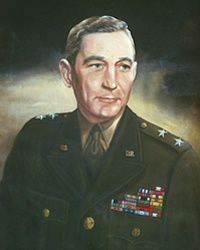Home - QM Leadership - Current QMC - Past QMCs - QMG MG Larkin
32nd Quartermaster General
Major General Thomas B. Larkin
Quartermaster General | February 1946 - March 1949
 As Quartermaster General, Larkin launched the program for return and final burial of American service personnel and civilians who died overseas during World War II. He scheduled a progressive plan for extensive peacetime research and development by the Quartermaster Corps which was designed to benefit the armed forces.
As Quartermaster General, Larkin launched the program for return and final burial of American service personnel and civilians who died overseas during World War II. He scheduled a progressive plan for extensive peacetime research and development by the Quartermaster Corps which was designed to benefit the armed forces.
Thomas Bernard Larkin was born in Louisburg, Wisconsin on 15 December 1890, and graduated from Gonzaga University in Spokane, Washington, with the degree of Bachelor of Arts in 1910. He entered the United States Military Academy at West Point, New York, a year later and was commissioned as a Second Lieutenant in the Corps of Engineers in 1915.
Upon graduation from West Point, he was assigned to Washington, DC as a student officer at the Engineer School and in 1916 went to Mexico for duty with the 2nd Engineers. After returning to the United States he completed his course at the Engineer School, graduating in 1917, and then attended American University in Washington, D.C.
In December 1917, he went to France and served first on the British Front. Later he took part in the Battle of the Marne, the Oise-Vesle Offensive, and the Battle of the Argonne. For his action in performing reconnaissance in the Marne area during July 1918, he was awarded the Silver Star. Shortly before the close of World War I, General Larkin went to Chatillon-sur-Seine, France, as Director of the 2nd Corps Engineer School, a position in which he served until April 1919.
Returning to the United States in 1919, he was assigned as an instructor at the Engineer School, Camp Humphreys, Virginia, and the following year began a tour of duty in the Office, Chief of Engineers, in Washington, DC. From 1921 to 1923 he was assigned as Assistant Military Attaché, American Embassy, Tokyo, Japan.. Upon returning to the United States he was assigned once again to the Office, Chief of Engineers, during which time he attended the Army Industrial College, graduating in 1927.
From 1928 to 1929 he attended the Command and General Staff School at Fort Leavenworth. Then he served as Assistant and later the District Engineer at Vicksburg District, Vicksburg, Mississippi.
In 1937 he enrolled in the Army War College, Washington, DC. and a year later attended the Naval War College at Newport, Rhode Island. There followed a tour of duty in the Panama Canal Zone where he served on the staff of the Governor of the Panama Canal Department.
General Larkin returned to the United States at the start of Wor1d War II, and in March 1942 was assigned to Headquarters, Army Air Forces in Washington, DC. The following May he went to the England to serve in Headquarters, Services of Supply. While the Allied Forces were preparing for the invasion of North Africa, General Larkin was named Commanding General of the Services of Supply, Mediterranean Base Sector. The following February he became Commanding General of Services of Supply, North African Theater of Operations and a year later was given the additional command of the Communications Zone, Mediterranean.Theater of Operations. For his efforts in supplying the combat troops during the Tunisian Campaign he was awarded the Distinguished Service Medal in June 1943. In November 1944, he assumed command of Headquarters, Southern Line of Communications, European Theater of Operations, France. For his logistical planning for the invasion of Southern France and support of the Fifth Army advance to the Po Valley in Italy, he received an Oak Leaf Cluster to the Distinguished Service Medal.
After further service in the European Theater of Operations, General Larkin returned to the United States in October 1945, and was named Commanding General of the Second Service Command at Governor's Island, New York.
In January 1946, he was named by President Truman as Quartermaster General of the Army. He served in that capacity until March 1949. His next assignment was as the Army's Director of Logistics (later redesignated as Assistant Chief of Staff for Logistics), for which he was promoted to the rank of Lieutenant General. He served in this post until his retirement on 31 December 1952. General Larkin Died at Walter Reed General Hospital in Washington, DC on 17 October 1968. He was buried with full military honors at Arlington National Cemetery.
General Larkin's awards include the; Distinguished Service Medal with two Oak Leaf Clusters, Legion of Merit, Silver Star, Bronze Star, French Croix de Guerre with Palm, the Brazilian Order of Military Merit, the Order of the Crown of Italy (Grand Order), the British Order of the Bath Companion, and the Polish Gold Cross with Sword.
The Larkin Conference Center on Fort Gregg-Adams, Virginia is named after General Larkin's son, Lieutenant Harrison Larkin. Lieutenant Larkin was an Air Force officer killed in a training accident in Virginia.
